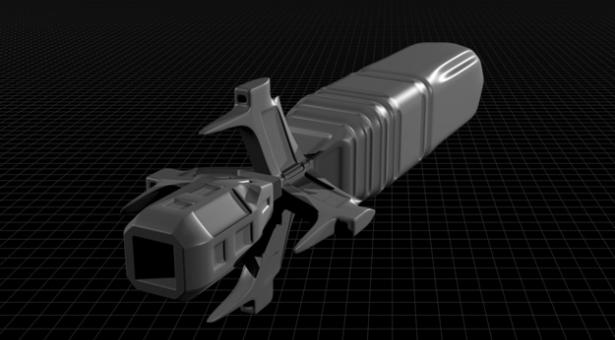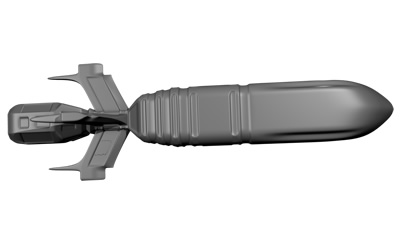

torpedo system

The vessel's primary armament is based around a system of railgun-launched self-guided missiles referred to as torpedoes.
These torpedoes use the kinetic energy created by their high velocity (tens of thousands of kilometers per second at launch) to penetrate target hulls, where a fused secondary charge ignites remaining guidance-system propellant to create an explosion and shrapnel, damaging the target's vulnerable inner compartments.
Operation
The torpedo system is designed as a multiple-purpose tactical delivery platform.
Configuring a torpedo for successful target prosecution requires the development of a firing solution, which takes account of the range and speed of launch and the torpedo's different flight modes.
Guidance Systems
 Torpedoes are equipped with multiple guidance systems which operate during different flight modes applied at different stages of the torpedo's deployment. These systems are capable of tracking target course changes, allowing the torpedo to change its own heading accordingly using its RCS system.
Torpedoes are equipped with multiple guidance systems which operate during different flight modes applied at different stages of the torpedo's deployment. These systems are capable of tracking target course changes, allowing the torpedo to change its own heading accordingly using its RCS system.
Targeting Assistance Data Transmission
Torpedoes are provided with target information immediately before launch by the vessel's target acquisition system. The torpedo continues to receive more detailed target information from the vessel than it's onboard guidance system can generate, via a constrained-beam high-frequency link (referred to as a 'wire').
The highly targeted nature of this link makes it difficult to jam and intercept, but the need for strict line-of-sight means that any significant course changes by the vessel or torpedo will break the link. Link transmitters mounted near each launcher are capable of dynamically adjusting the direction of transmission to compensate for course changes made by the torpedo.
Independent Passive Guidance
guidance systems which use a small EMDAR array to scan selected EM profiles useful for tracking targets.
Active Guidance
Torpedoes also include a basic RADAR system, which is typically not used until late in deployment to reduce the target profile presented by the torpedo to countermeasure systems.
This link is also capable of transmitting control data, including a change of target.
Reaction Control System
Torpedoes are equipped with a small Reaction Control System (RCS) used to make course changes requested by the guidance system.
The RCS is made up of a small chemical rocket engine with directional control provided by a servo-controlled output nozzle.
The torpedo's main velocity is momentum-based (with the initial momentum provided by the railgun launcher and the launch vessel's velocity).
Ordnance Configuration Options
Torpedoes use standardised flight casings into which a number of configurable ordnance and sensor options can be fitted, which allows the torpedo launch system to also deploy remote scientific probes.
Warhead Options
Different warheads can be fitted to torpedoes to suit tactical requirements.
Standard Armour-Piercing Configuration
The standard torpedo configuration consists of an armor-piercing casehead and a fused secondary explosive charge designed to ignite remaining RCS propellant and convert the torpedo case into shrapnel to damage interior compartments once the target hull has been penetrated.
Interchangeable Mission Packs
Different sensor packs can be fitted to torpedoes to suit tactical or other operations requirements.
Tactical Sensory Packs
The standard tactical sensory pack passively scans for target EM, heat and exhaust plasma emissions and can also actively scan using RADAR.
Operations Sensory Packs
A number of sensory packs can be fitted to convert torpedoes into probes. The standard sensor-pack compartment in the torpedo case is augmented by the addition of another compartment fitted in place of the warhead, to make room for extra sensory and processing equipment.








